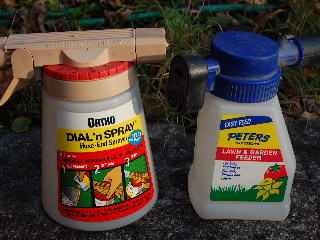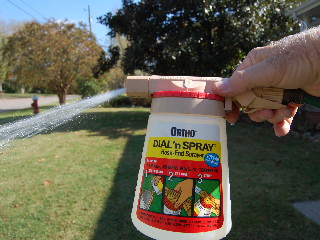
Here’s a handy tool for the home gardener.
The hose end sprayer is a plastic container with calibrated settings that allows you to easily apply liquid weed killers, fertilizers, and insect killers around your home and garden areas.
And it eliminates the need to strain your back lifting and loading those heavy bags of granulated "weed and feed" type products into a broadcast spreader.
Just set the dial for the type of concentrated product you’re using, pour the concentrate into the plastic receptacle, attach your garden hose, turn on the water, and you’re in business.
No need for measuring cups or extra containers to dilute and mix your product into before spraying.
And it’s as simple as watering your lawn; just apply the spray pattern evenly over the area you are treating to assure complete coverage.
A number of different companies manufacture and distribute these hose-end kind of sprayers. Two of the ones I’ve personally used and had good results with are the Ortho® Dial-N-Spray® device and the hose end sprayer made by the Peters® company.
I seem to have settled into using the Peters® sprayer for applying fertilizer products to the lawn and other landscaping plants and flowering foliage.
While the Ortho® sprayer feels more convenient for lawn grass weed control. You can’t get much simpler calibration than setting the dial to the recommended dosage for the product you are applying.
I find that the easiest method of insuring complete coverage of your lawn area is to begin at a corner of the lawn farthest away from the garden hose hookup. Begin spraying and slowly moving backwards (carefully) across the lawn.
This method allows you a better view of the area you’ve already treated and should minimize skipped and untreated patches.

The fact that you don’t dilute the product into the application reservoir allows you to return any unused product back into its original container after you have finished application.
One factor to note (I don’t think it’s really a negative) is that these hose-end sprayers actually work more efficiently if you’re treating a fairly large area or large number of plants.
If you just have a few scattered weeds in your lawn, it might be easier to use your gallon size tank sprayer or a container of “pre-mixed” product to spot spray only the desired areas.
After each use of your hose-end sprayer, remove any unused product, rinse out the reservoir with clean water, and allow it to air-dry before you put it away in your garden tool storage area.
With proper care, you should get many years of use out of this handy little tool.
 Here’s a handy tool for the home gardener.
Here’s a handy tool for the home gardener.
 The fact that you don’t dilute the product into the application reservoir allows you to return any unused product back into its original container after you have finished application.
The fact that you don’t dilute the product into the application reservoir allows you to return any unused product back into its original container after you have finished application.